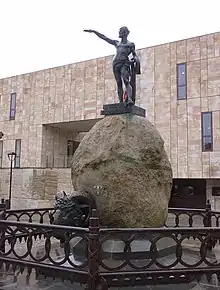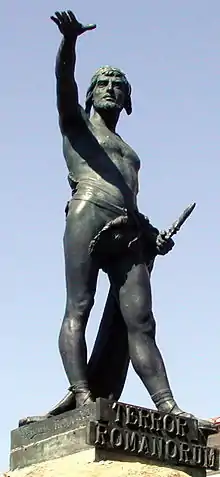Monument to Viriathus (Zamora)
Viriato or the Monument to Viriathus is an instance of public art in Zamora, Spain. Dedicated to Viriathus and located in the eponymous plaza, the monument consists of a bronze sculpture of the Lusitanian chieftain-shepherd put on an unpolished stone pedestal that features a battering ram.
 | |
| Coordinates | 41.502494°N 5.748472°W |
|---|---|
| Location | Plaza de Viriato, Zamora, Spain |
| Designer | Eduardo Barrón |
| Material | Bronze, granite |
| Height | 2 m (statue) |
| Opening date | 12 January 1904 |
| Dedicated to | Viriathus |
History and description
The statue is a work by Eduardo Barrón cast in bronze in Rome at Nelli's foundry in 1883; it was later bought by the Spanish State.[1]
The leading statue of the sculptural ensemble represents a standing and almost naked full-body figure of Viriathus, with his right arm extended in attitude of rallying his troops, while the left forearm holds a tunic and the left hand grabs a sheathed sword below the level of an abnormally long handle (creating a phallic perception from certain angles).[2][3]
The statue stands 2-metre high and its bronze base reads terror romanorum ("terror of the Romans"),[4] an epithet for Viriathus attributed to the Orosius' chronicles. The statue and the quadrangular base stand on a granite pedestal taken from Torrefrades, one of the pretenders claimed to be the Viriatho's birthplace.[5] The granite block features a battering ram emerging from its front side,[1] cast in bronze in 1903.[6]
Failing to undergo a proper ceremony of inauguration, the monument was casually unveiled by transients on 12 January 1904.[7]
The monument, with Viriathus' posture identified as performing a roman (fascist) salute, was embraced by the Falange as an icon during the Francoist dictatorship.[8]
 Detail of the head of the battering ram
Detail of the head of the battering ram Detail of the statue
Detail of the statue
References
- Citations
- Rincón García 2017, p. 184.
- Ocejo Durand 2002, p. 230.
- Rincón García 2017, pp. 185–186.
- Ocejo Durand 2002, p. 234.
- Ocejo Durand 2002, pp. 234; 236.
- Ocejo Durand 2002, p. 236.
- Ocejo Durand 2002, p. 247.
- Ocejo Durand 2002, p. 251.
- Bibliography
- Ocejo Durand, Nel (2002). "Estudio del grupo escultórico de Viriato de Eduardo Barrón González en Zamora" (PDF). Studia Zamorensia. Zamora: Universidad Nacional de Educación a Distancia (6): 229–254. ISSN 0214-736X – via Dialnet.
- Rincón García, Wifredo (2017). "Muerte y amor en la escultura española del siglo XIX" (PDF). In Castán Chocarro, Alberto; Lomba Serrano, Concha (eds.). Eros y Thánatos: reflexiones sobre el gusto III. pp. 183–206. ISBN 978-84-9911-434-7.